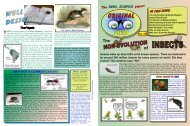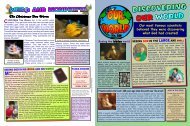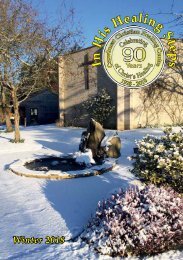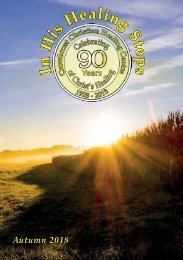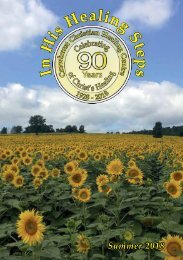CRT-OV-89
CRT-OV-89
CRT-OV-89
Create successful ePaper yourself
Turn your PDF publications into a flip-book with our unique Google optimized e-Paper software.
By Averator: Wikipedia<br />
Lithops plants have been nicknamed “Living Stones” — and for<br />
a very good reason. These plants look just like pebbles, and<br />
since they naturally grow in dry, desert areas, they are perfectly<br />
camouflaged to blend in with their surroundings.<br />
These unusual plants were accidentally discovered in South<br />
Africa in 1811 by explorer botanist and artist William John<br />
Burchell, when he picked up a "curiously shaped pebble.” Because<br />
their camouflage is so effective, new species are still<br />
being discovered in remote<br />
regions of Namibia<br />
and South Africa. Most of<br />
the plant is below ground<br />
level, where there is a<br />
water storage layer. Only<br />
the tops of the leaves are<br />
above the ground. The<br />
tops are transparent to<br />
allow light to reach the<br />
green cells inside. These<br />
Lithops flowers emerging<br />
“leaf windows” are tinted<br />
WHY NOT GOD?<br />
We find it puzzling that so many scientists invoke incredible<br />
and outlandish theories, rather than consider the possibility<br />
that our universe, and life on earth, are the result of creation<br />
by an all-powerful Creator. To escape the problem of a beginning,<br />
and what was there before the beginning, some cosmologists<br />
suggest that our universe is just like one bubble in a<br />
mass of universes. Journalist Tim Folger wrote. ‘Short of invoking a benevolent creator,<br />
many physicists see only one possible explanation. Our universe may be but one of perhaps<br />
infinitely many universes in an inconceivably vast multiverse.’ He quoted cosmologist<br />
Bernard Carr: ‘If you don’t want God, you’d better have a multiverse.’ 1<br />
Is our universe like a<br />
bubble in a multi-verse?<br />
There’s no evidence that other universes exist, and there<br />
are lots of problems with the ‘big bang’ theory. So why the<br />
reluctance to accept a supernatural origin? Is it because<br />
believing in God has implications, such as whether we are<br />
answerable to Him? If so, such a fear is unnecessary. We<br />
believe that God loves us, and wants to have a relationship<br />
with us. We certainly are answerable to Him, since we’ve all<br />
sinned and become separated from God. But He has made a<br />
way for us to come back to Him, through His Son, Jesus<br />
Christ. The Bible says that we can have “peace with God<br />
through our Lord Jesus Christ.” (Romans 5: 1). This is because<br />
Jesus died on the cross to take the punishment due to us, then rose again. He said,<br />
“Whoever hears my word and believes him who sent me has eternal life and will not be<br />
judged but has crossed over from death to life.” (John 5: 24). Faith in Him brings real freedom!<br />
1. Quoted in New Scientist, 2685, page 48, 6th December 2008.<br />
A group of Lithops plants<br />
red — perfect for allowing them to transmit red light<br />
for photosynthesis but preventing the plant from<br />
looking green, so that plant-eating animals won't spot<br />
them. When the plants flower, usually in autumn or<br />
winter, beautiful blooms emerge from the crack that<br />
divides each plant.<br />
Lithops have also become very popular as house<br />
plants, and can be bought in many nurseries, as well<br />
as easily grown from seed.<br />
What gradual, evolutionary process could have<br />
caused the Lithops plant to develop its special<br />
apparatus for surviving in desert conditions, and<br />
its uncanny resemblance to stones? This looks<br />
like intelligent design, not chance!<br />
Did you hear about the<br />
mathematician who’s afraid<br />
of negative numbers?<br />
He’ll stop at nothing to<br />
avoid them.<br />
What’s an astronaut’s<br />
favourite part on a<br />
computer?<br />
The space bar.<br />
Original View is published three times<br />
a year by the Creation Resources<br />
Trust (Reg. Charity No. 1016666).<br />
Editing, design and layout by Geoff<br />
Chapman. Unless otherwise stated,<br />
articles are written by the editor.<br />
There is no subscription charge, but<br />
donations are invited. Contact <strong>CRT</strong> at<br />
P O Box 3237, YE<strong>OV</strong>IL, BA22 7WD.<br />
Phone: 01935 850569. E-Mail:<br />
info@crt.org.uk. Other resources,<br />
e.g. DVDs, CDs, books, literature,<br />
etc., also available by post or on-line<br />
at www.crt.org.uk Unless otherwise<br />
stated, Scriptures are taken from the<br />
HOLY BIBLE NEW INTERNATION-<br />
AL VERSION © 1973, 1978, 1984 by<br />
the International Bible Society. Used<br />
by permission of Hodder &<br />
Stoughton. All rights reserved.<br />
Illustrations in this issue from<br />
Clipart.com and Wikipedia.com<br />
By Christer Johansson: Wikipedia<br />
© 2019. Printed by CPO Worthing<br />
Image: therpf.com<br />
ORIGINAL<br />
OUR<br />
VIEW No. <strong>89</strong><br />
IN THIS ISSUE….<br />
Scientists speculate about nothing!<br />
Our indispensable moon<br />
Big bang under fire<br />
A Bible-believing Scientist<br />
It’s against the law!<br />
Well Designed: The Lithops Plant<br />
Why not God?<br />
UNIVERSE!<br />
It’s really a miracle that we are here!<br />
“Why are we here?” That’s a question that<br />
people have been asking for centuries. Secular<br />
science has no real answer to this. In fact,<br />
many scientists admit that, according to scientific<br />
laws, we really ought not to be here!<br />
The First Law of Thermodynamics tells us<br />
that matter (mass/energy) can be changed,<br />
but can neither be created nor destroyed.<br />
This means that physical processes couldn’t<br />
have created the universe from nothing. The<br />
Second Law of Thermodynamics states that<br />
an isolated system always becomes more<br />
disorderly over time.<br />
“<strong>OV</strong>ERWHELMINGLY UNLIKELY”<br />
According to scientist Amanda Gefter: “Some basic physics suggests that you and the rest of the universe are<br />
overwhelmingly unlikely to exist. The second law of thermodynamics, that most existentially resonant of<br />
physical laws, says that disorder, or entropy, always tends to increase.” 1 Both these basic laws of science<br />
undermine the “big bang” theory. The late Dr Isaac Asimov wrote: “Its explosion represented a vast shift in the<br />
direction of disorder, and ever since, the amount of disorder in the Universe has been increasing.” 2<br />
Some scientists seek to get around the problem by proposing that some parts of the<br />
Universe were gaining in useful energy at the expense of other regions which were not.<br />
Since there is no proof of this, it seems to be merely an attempt to solve the dilemma.<br />
Amanda Gefter raised a further problem for the “big bang” theory: “According to the<br />
theory, matter and antimatter were created in equal amounts at the big bang. By rights,<br />
they should have annihilated each other totally in the first second or so of the universe’s<br />
existence. The cosmos should be full of light and little else. And yet here we<br />
are. So too are planets, stars and galaxies; all, as far as we can see, made exclusively<br />
out of matter. Reality 1: Theory 0.” 3.<br />
1. Existence: Why is there a universe?” New Scientist, 20th July 2011. 2. In the Beginning (New York: Crown<br />
Publishers, 1981), p. 24. 3. ‘Antimatter mysteries 1” New Scientist.com 27th April 2009.
Scientists speculate about nothing!<br />
Scientists who believe the universe evolved from nothing sometimes make<br />
strange statements. Below are a few gems:<br />
“The big bang was the abrupt creation of the Universe from literally nothing:<br />
no space, no time, no matter. This is a quite extraordinary conclusion to<br />
arrive at — a picture of the entire physical Universe simply popping into existence<br />
from nothing.” —Paul Davies & Jeremy Gribben, ‘The Matter Myth’,<br />
1992, p. 122.<br />
“There's no such thing as a free lunch, or so the saying goes, but that may<br />
not be true on the grandest, cosmic scale. Many physicists now believe that<br />
the universe arose out of nothingness during the Big Bang, which means<br />
that nothing must have somehow turned into something.” —New Scientist<br />
TV 28 th July 2011.<br />
“To the average person it might seem obvious that nothing can happen in<br />
nothing. But to a quantum physicist, nothing is, in fact, something..… Quantum<br />
theory also holds that a vacuum, like atoms, is subject to quantum uncertainties.<br />
This means that things can materialize out of the vacuum,<br />
although they tend to vanish back into it quickly.... this phenomenon has<br />
never been observed directly.” —Discover, April 2002 (emphasis added)<br />
In the real world, 0 + Time = 0. In the fantasy world of the “big bang”<br />
0 + Time = Everything!<br />
UR INDISPENSABLE M<br />
DURING our life, most of us will see around<br />
1,000 full moons, but how many people know<br />
that without the moon we wouldn’t be here? It is a<br />
fact that life on earth would be impossible if the<br />
moon didn’t exist. The moon’s gravitational pull<br />
keeps the earth quite stable as it orbits the sun.<br />
Without it, our planet might wobble erratically, making<br />
our climate too chaotic for life. The moon also<br />
slows the earth’s rotation. If you think days are too<br />
short to get everything done, then take note of the<br />
fact that without the moon’s pull a day might only<br />
last between 6 and 12 hours!<br />
The size of the moon is also crucial in relation to<br />
our twice-daily tides. Without these movements,<br />
many of the creatures which live in rock pools<br />
(right) would not survive, since they rely on the<br />
tides to bring them a supply of food. The tides<br />
also aerate the water, preventing it from becoming<br />
stagnant. If the moon were much larger, the<br />
tides would sweep far inland, making many<br />
N<br />
coastal areas uninhabitable. On the other hand, a much smaller moon would<br />
result in tides which were too weak to do any good. Tides also mix cold arctic<br />
water with warmer tropical water, keeping our climate more equable.<br />
There have been a number of theories to<br />
explain the origin of the moon. Currently popular<br />
is the idea that, millions of years ago, a<br />
NASA image<br />
EARTH AND MOON<br />
Mars-sized object collided with the earth and<br />
resulted in the formation of the moon (left).<br />
Could an accidental planetary collision — for<br />
which there is no hard evidence — really produce<br />
our unique neighbour in space?<br />
We seem to have exactly the kind of moon we<br />
need for our existence. This suggests purposeful,<br />
intelligent design, not chance!<br />
NASA image<br />
Will the<br />
universe<br />
run out<br />
of energy?<br />
The First Law of Thermodynamics<br />
states that energy cannot be created<br />
or destroyed, but it can be transformed<br />
from one form to another.<br />
However, the amount of useable<br />
energy decreases with time, which<br />
is why it’s impossible to make a<br />
perpetual motion machine. This<br />
means that, left to itself, the universe<br />
would eventually die a “heat<br />
death” as it ran out of useable energy<br />
and all processes ceased. Christians<br />
believe that, before that<br />
happens, God will intervene to create<br />
“a new heavens and earth.” (see<br />
The Bible, 2 Peter 3: 13)<br />
‘BIG BANG’<br />
UNDER FIRE<br />
In the 22nd May 2004 issue of the<br />
New Scientist journal, a group of 33<br />
scientists published an open letter<br />
challenging the ‘big bang’ theory.*<br />
The statement began: "The big bang<br />
today relies on a growing number of<br />
hypothetical entities, things that we<br />
have never observed — inflation,<br />
dark matter and dark energy are the<br />
most prominent examples. Without<br />
them, there would be a fatal contradiction<br />
between the observations<br />
made by astronomers and the predictions<br />
of the big bang theory. In no<br />
other field of physics would this continual<br />
recourse to new hypothetical<br />
objects be accepted as a way of<br />
bridging the gap between theory and<br />
observation. It would, at the least,<br />
raise serious questions about the validity<br />
of the underlying theory. But the<br />
big bang theory can't survive without<br />
these fudge factors.”<br />
The signatories accused supporters<br />
of the ‘big bang’ of being biased because<br />
of the funding they receive,<br />
and called for research into alternative<br />
theories. Since 2004 many more<br />
scientists have added their names.<br />
*www.cosmologystatement.org<br />
in5d.com<br />
Dr John Hartnett – Physicist and cosmologist*<br />
Not all physicists and cosmologists believe the universe began with a ‘big bang.’ Dr John<br />
Hartnett, who received both his B.Sc. (hons) and Ph.D. from the University of Western<br />
Australia, is one of the dissenters. He has published more than 100 papers in peer-reviewed<br />
scientific journals. Now retired, he remains an adjunct Associate Professor at the University of<br />
Adelaide.<br />
Dr Hartnett was interested in cosmology from an early age, and says that he would once have called himself an<br />
atheist who believed in the ‘big bang.’ Yet he recognised “there was actually very little in the way of specifics<br />
about this model. It was this that drove me into further investigation.” He says, “Most people think that the big<br />
bang has already been worked out, but they don’t realize that there are differing versions of the big bang<br />
model—and not everyone agrees. By inserting a few unprovable assumptions at your starting point, you can end up<br />
with virtually any model you like.”<br />
Dr Hartnett, who co-authored the book Dismantling the Big Bang, says, “This cosmic evolution story<br />
is a complete epic, which starts with just hydrogen gas and after 13.7 billion years ends up with<br />
people and all sorts of living creatures on a beautiful blue fertile planet at ‘just the right distance’<br />
from the sun that ‘only looks like’ it was designed for life. The story is still being written, as the big<br />
bang description keeps changing and evolving.” 1<br />
Dr Hartnett refutes the popular theory that the first stars formed when a huge cloud of mostly<br />
hydrogen and some helium contracted under its own gravity, and eventually heated up so much that<br />
thermonuclear fusion began in its core. “Real science tells us that a contracting gas cloud heats up,<br />
and the resulting increased gas pressure prevents any further collapse of the cloud.” He believes<br />
that the big bang theory is used to “deceive the world”, and that the true history of the world is outlined in the<br />
Bible. 1. creation.com/cosmic-storytelling.<br />
*Information in this article from creation.com/exploding-the-big-bang, courtesy of Creation Ministries International<br />
© www.justoutsidetheboxcartoon.com by kind permission<br />
IT’S AGAINST THE LAW!<br />
Mum, you can’t fight the 2nd Law of Thermodynamics. All things,<br />
which includes bedrooms, move from a state of order to disorder.<br />
This is how the late Dr Isaac Asimov described the Second Law: “The<br />
universe is constantly getting more disorderly! We have to work hard<br />
to straighten a room, but left to itself, it becomes a mess again very<br />
quickly and very easily .... How difficult to maintain houses, and<br />
machinery, and our own bodies in perfect working order; how easy<br />
to let them deteriorate. In fact, all we have to do is nothing, and<br />
everything deteriorates, collapses, breaks down, wears out, all by<br />
itself . . . and that is what the Second Law is all about." –Smithsonian<br />
Institution Journal (June 1970), p. 6.<br />
2,700 years ago the prophet Isaiah described the eventual effects of<br />
the Second Law: “Lift up your eyes to the heavens, look at the earth<br />
beneath; the heavens will vanish like smoke, the earth will wear out<br />
like a garment.” (The Bible Isaiah 51: 6)<br />
Theory<br />
It seems impossible that an explosion from a<br />
central point could result in our complex, functioning<br />
universe. How could matter, flying apart<br />
at tremendous speeds from the ‘big bang’, start<br />
to come together to form spinning galaxies,<br />
clusters of stars, and eventually planetary systems,<br />
some with moons in orbit around them?<br />
There’s no known physical process that could<br />
cause this to happen. It’s rather like expecting<br />
an explosion in a builder’s yard to result in the<br />
materials falling together in the form of a house!<br />
Every house is built by<br />
someone, but God is<br />
the builder of<br />
everything.” (The Bible,<br />
Hebrews 3: 4)<br />
Credit: CERN/Universe Today






